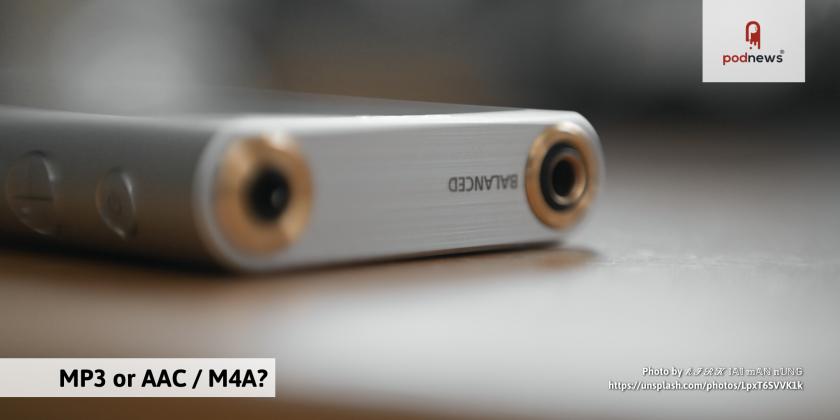
How to encode your audio: MP3 or AAC / M4A?

This article is at least a year old
Podcast files can be in two audio formats - MP3, or AAC. Chances are, you listen to both, without even being aware of it.
But if you’re making a podcast, what should you use? MP3 or AAC?
MP3 format
You’re probably familiar with MP3 - properly known as “MPEG-1 Audio Layer III”. It’s a standard for audio and has been with us since 1993.
MP3 files are playable on almost anything, and the patents for MP3 expired in 2017, so it’s free to build an MP3 player or encoder.
You can produce MP3 files in two bitrate formats - constant bitrate or variable bitrate. Variable bitrate causes quite a few problems for podcasts, and the general advice is not to use variable bitrate (sometimes known as VBR) for podcasting.
AAC format
AAC files typically end with .m4a so some people call them “M4A files”, but the audio codec they use is AAC, and we’ll use that name in this article.
AAC stands for “Advanced Audio Coding”, and it was initially released in 1997. However, in most cases, “AAC” really means “HE-AAC v2” for the purposes of this article, at least at lower bitrates. HE-AAC v2 was standardised in 2006, and is v2 of the “High Efficiency” version of the codec.
There are still patents on AAC decoders, so device manufacturers need to pay money to the patent owners. However, if a device wants to play back video - like your mobile phone does, for example - it’ll already have AAC decoders paid-for, so in practice, almost everything these days has AAC support.
Virtually every podcast host will let you upload an AAC file.
In late 2019, it was calculated that 4.3% of podcasts have chosen to use AAC format; but since Anchor automatically produces podcasts in AAC format (and has many different podcasts hosted on it), 39% of new podcasts use AAC.
Benefits of AAC over MP3
- AAC offers much better audio quality at the same bitrate - or, and probably more usefully, great quality at much lower bitrate. For most people, an AAC file at 64kbps sounds about the same as an MP3 file at 128kbps.
- Lower bitrate means lower filesize, and that means it’s cheaper to host, cheaper and faster to download, quicker to stream, and takes up less space on your listener’s phone.
Downsides of AAC over MP3
- Spotify and Deezer require MP3 format files, and do not import AAC files at all. For this reason alone, you probably still need to be producing MP3 versions of your podcast.
- Amazon Alexa’s News Briefing service also requires MP3 files. It’s unlikely you’ll use this, but worth knowing.
- Dynamic content insertion (used, mainly, for ads) typically don’t accept AAC format files.
- With an MP3, chapter points are listed at the front of the file, allowing podcast apps who support them to be able to use them as soon as the file starts loading. With AAC, chapter points are listed throughout the file, making it harder to support chapter points if streaming a podcast.
- A tiny percentage of devices (easily less than 1%) don’t play AAC files, or only decode the “AAC” bit and not the “HE-AAC v2” bit, which means it sounds muffled and of poor quality.
Should you use AAC or MP3?
We think the answer to this question is “no”. You shouldn’t use one or the other; you should use both.
It’s very clear that AAC produces nicer-sounding audio than MP3. So if you care about your audio, you should be producing a nice AAC version.
It’s also clear that AAC produces nice-sounding audio at lower bitrates - and therefore filesizes - than MP3. So if you care about your audience’s data bills, you should be producing an AAC version.
However, you should also produce an MP3 version for products that need it - most notably, Spotify.
We produce:
- a 256kbps MP3 version of our podcast for Spotify and Amazon’s News Briefing. We author this to -14 LUFS, which both of these platforms have asked for. Both Spotify and Amazon cache the audio in their systems.
- an 80kbps AAC version of our podcast for everyone else. We author this to -16 LUFS, which both Apple and Google have asked for.
We can do the above because we host our podcast ourselves. But you probably (and hopefully) use a proper podcast host.
Some podcast hosts, like ART19, prefer you to upload a WAV or AIFF file: and let them re-encode it. This allows their ad-insertion to work as intended, without a loss of quality.
However, most podcast hosts don’t touch your audio when you upload it: and in which case you need to choose one or the other.
If you can only choose one format, should you choose AAC or MP3?
MP3. It’s the only one Spotify understands, and if Spotify is 20%+ of all podcast listens, you should probably go with that.
Some podcast hosts, like Libsyn or Blubrry, will automatically convert your audio from AAC to MP3 for Spotify’s benefit. But that inevitably comes with a decrease of audio quality. And you probably don’t want your audio fiddled with. Better, we think, to author it in MP3 in the first place.
(Agree? Disagree? Let us know in the comments.)
































































































